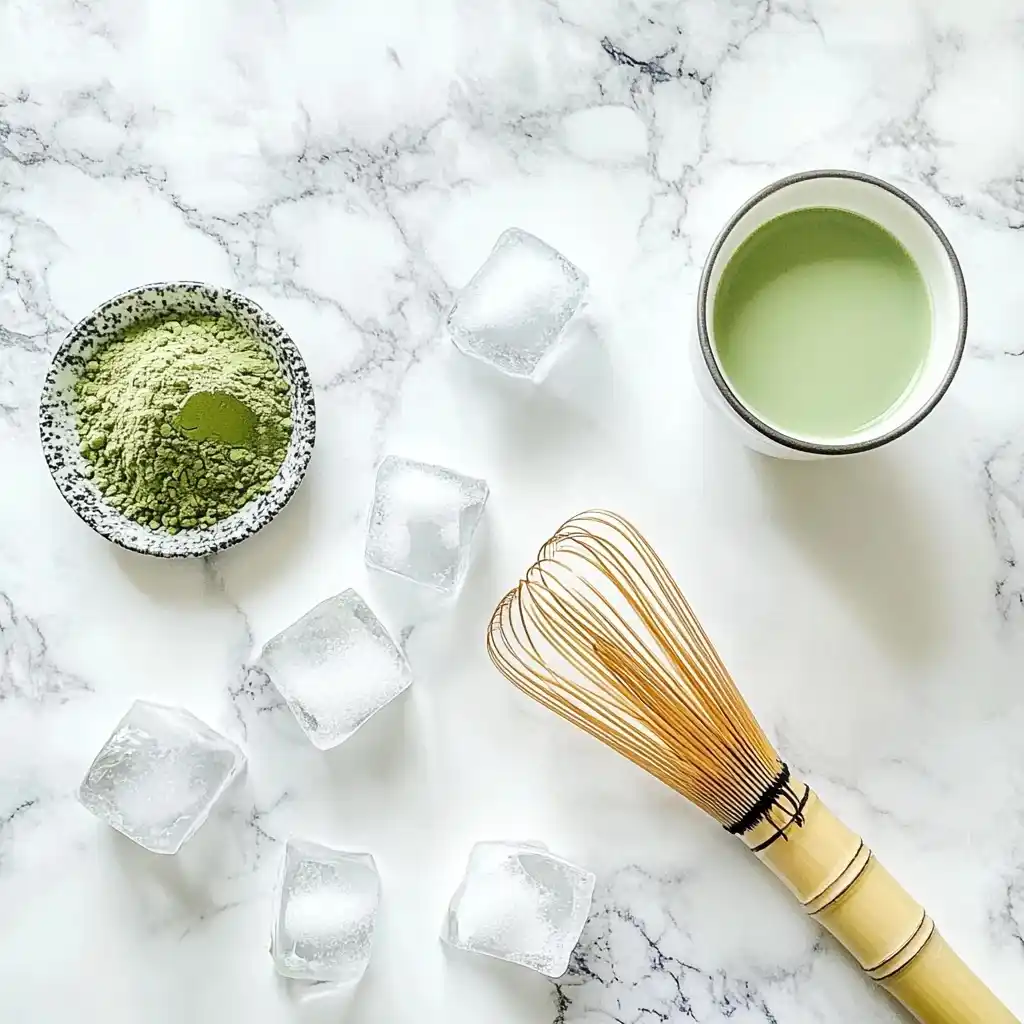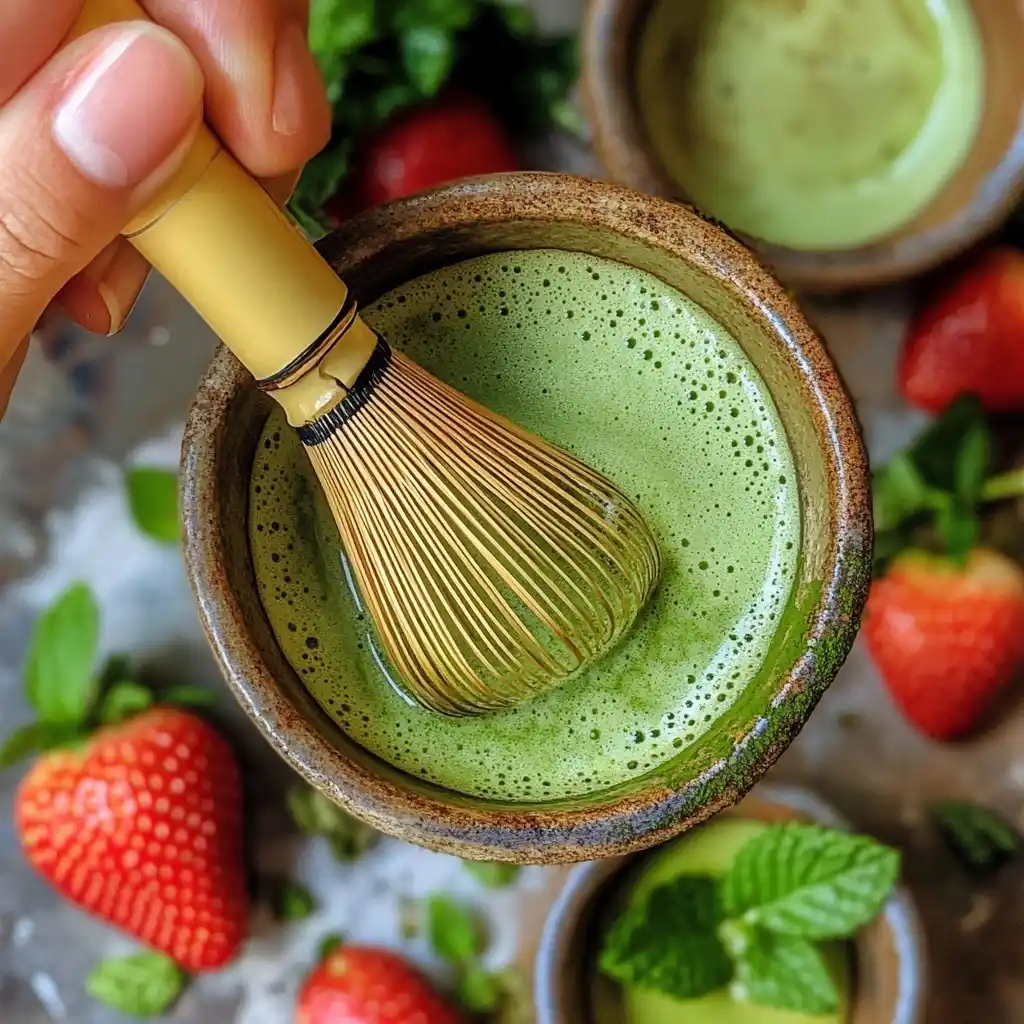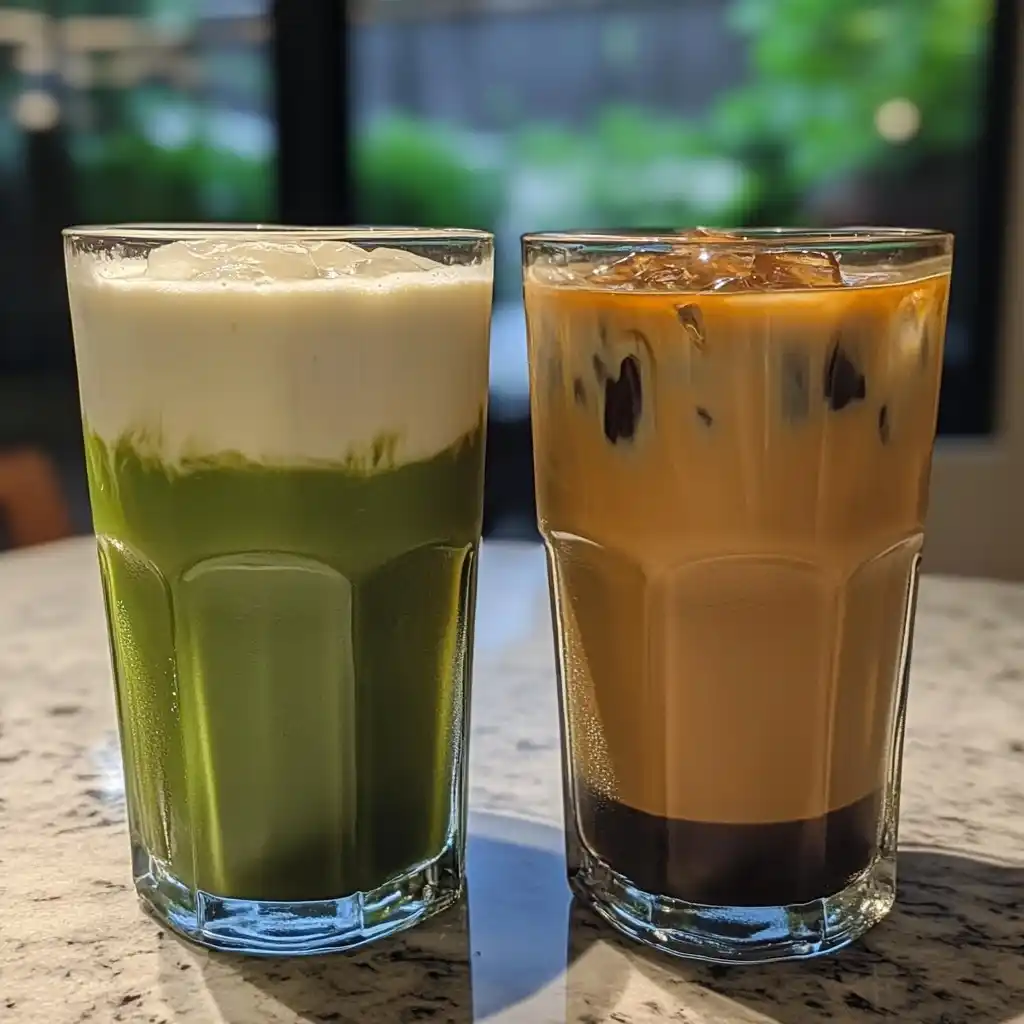Iced matcha latte is more than just a pretty green drink trending on social media—it’s a refreshing, health-boosting ritual that blends centuries-old tradition with modern flavor. And for me, it’s also deeply personal.
My passion for cooking began in a small, peaceful town in America, where the skies stretched wide and the air carried the scent of summer berries. As an only child, I often found myself at my grandma’s house next door. Her garden was her pride and joy—filled with tomatoes, fragrant herbs, and my favorite of all: sweet, sun-warmed strawberries.
Her kitchen was my first culinary classroom. I watched her transform garden-fresh ingredients into the kind of food that didn’t just fill your belly—it filled your heart. Even a simple glass of cold tea felt special in her hands. It’s from her I inherited the belief that what you create in the kitchen has the power to connect people.
Though my grandma is no longer with us, every recipe I share is a tribute to her. And this iced matcha latte recipe? It’s the kind of thing she would’ve loved on a warm afternoon—a blend of wholesome green tea and creamy milk, poured over ice, and enjoyed on the porch with the sound of bees buzzing nearby.
Whether you’re a matcha newbie or a long-time fan, you’ll learn everything you need to know about this vibrant green latte—from its ingredients and benefits to how it compares to coffee. You’ll even find a step-by-step guide to make the perfect iced matcha latte at home.
Discover great ideas like the Iced Strawberry Matcha Latte, a fruity twist that brings my grandma’s beloved berries into this modern classic.
Let’s dive in.
Table of Contents
What Is an Iced Matcha Latte?
What exactly is matcha and how is it different from regular green tea?
At first glance, matcha might look like nothing more than finely ground green powder. But don’t let its simple appearance fool you—it’s one of the most nutrient-dense forms of tea in the world. Unlike traditional green tea, which is steeped in hot water and discarded, matcha is made from entire green tea leaves that have been carefully grown in the shade, harvested, dried, and stone-ground. When you drink matcha, you’re consuming the whole leaf, which means you’re getting every bit of its goodness.
This process results in higher levels of antioxidants, especially EGCG (epigallocatechin gallate), which has been studied for its cancer-fighting and heart-health-promoting properties. It also delivers a calm, focused energy thanks to the presence of L-theanine, an amino acid that promotes relaxation without drowsiness.
So what sets an iced matcha latte apart from other green teas? It’s not only the format—cold, creamy, and often lightly sweetened—but also the way matcha’s grassy, umami-rich flavor pairs beautifully with milk. That balance of smooth dairy and slightly bitter matcha creates a drink that’s as refreshing as it is restorative.
How does an iced matcha latte differ from a hot one?
While both hot and iced matcha lattes are made using the same core ingredients—matcha powder, water, and milk—their vibe and experience couldn’t be more different.
A hot matcha latte offers comfort and warmth, ideal for chilly mornings or a relaxing evening wind-down. The flavors are more pronounced, and the drink has a slightly thicker texture when steamed milk is used.
On the other hand, an iced matcha latte is crisp, cool, and energizing—perfect for warm afternoons or post-yoga refreshment. The cold temperature tends to mellow out the grassy flavor of matcha, making it more approachable for first-timers. Ice adds a layer of lightness, and if you use plant-based milk like oat, almond, or coconut, the drink becomes even more refreshing and creamy.
Check out this revitalizing Watermelon Salad with Cucumber and Feta, another great summer treat that pairs well with an iced matcha latte.
Here’s a quick comparison:
| Feature | Hot Matcha Latte | Iced Matcha Latte |
|---|---|---|
| Temperature | Warm & comforting | Cold & refreshing |
| Milk Texture | Frothy/steamed | Creamy or light |
| Flavor Intensity | Stronger, deeper | Milder, slightly sweeter |
| Best Time to Drink | Morning or evening | Mid-day or hot afternoons |
| Customization Options | Limited (hot milk only) | More flexible (plant milks, syrups) |
Whether you prefer sipping something warm by the window or cooling down with a chilled drink on your porch, there’s a matcha latte style for you.
Print
Iced Matcha Latte
A creamy, refreshing iced matcha latte made with high-quality matcha, your choice of milk, and just the right touch of sweetness—perfect for a hot afternoon or a gentle energy boost.
- Total Time: 5 minutes
- Yield: 1 serving 1x
Ingredients
1–1½ teaspoons high-quality matcha powder
2 tablespoons hot (not boiling) water
1 cup milk of choice (dairy, oat, almond, etc.)
½ cup ice cubes
1–2 teaspoons sweetener (optional: honey, maple syrup, or vanilla syrup)
Instructions
Sift the matcha powder to remove clumps.
Whisk matcha with hot water until frothy and fully dissolved.
Stir in sweetener while matcha is still warm, if desired.
Fill a glass with ice cubes and pour in the milk.
Top with the prepared matcha mixture.
Stir and enjoy your iced matcha latte!
Notes
Use ceremonial grade matcha for the best flavor and a smooth, non-bitter finish. Try it with plant-based milks like oat or almond for a dairy-free option.
- Prep Time: 5 minutes
- Cook Time: 0 minutes
- Category: Drink
- Method: No-cook
- Cuisine: Japanese-Inspired
Nutrition
- Serving Size: 1 glass
- Calories: 90
- Sugar: 4g
- Sodium: 40mg
- Fat: 3g
- Saturated Fat: 0.5g
- Unsaturated Fat: 2.5g
- Trans Fat: 0g
- Carbohydrates: 8g
- Fiber: 1g
- Protein: 3g
- Cholesterol: 0mg
Keywords: iced matcha latte, matcha, green tea latte, summer drinks, healthy drink
Health Benefits of Iced Matcha Latte
Is iced matcha latte healthy?
Absolutely. An iced matcha latte is not just a tasty alternative to sugary coffee drinks—it’s a nutritional powerhouse, especially when made with clean ingredients. Matcha itself is rich in antioxidants, particularly catechins like EGCG, which help fight free radicals, reduce inflammation, and support cell health.
The health benefits you get depend largely on how you prepare it. When you skip refined sugars and opt for plant-based or low-fat milk, your iced matcha latte becomes a low-calorie, high-impact drink perfect for your daily wellness routine.
Let’s take a closer look at why this green drink deserves a place in your fridge:
- Detoxification Support: Matcha is loaded with chlorophyll, which helps naturally detox your body by removing heavy metals and harmful chemicals.
- Boosts Brain Function: The combination of caffeine and L-theanine sharpens focus without the jitters. It’s ideal for anyone seeking sustained mental clarity without the crash that coffee often brings.
- Aids Weight Management: Some studies suggest that matcha can help boost metabolism and fat burning, making it a great addition to a weight-conscious lifestyle.
- Supports Heart Health: Antioxidants in matcha help lower bad cholesterol levels and blood pressure, reducing the risk of heart disease over time.
- Strengthens the Immune System: With antiviral and antibacterial properties, matcha helps your body fend off illness.
And unlike many store-bought lattes, making it at home gives you full control over sweetness, milk choice, and portion size. You can even add supplements like collagen or adaptogens for extra health perks.
Don’t miss our Natural Mounjaro Recipe for another easy, low-calorie drink that fits perfectly into a healthy lifestyle.
Key nutrients in matcha: antioxidants, catechins, and L-theanine
Let’s break it down:
| Nutrient/Compound | Function & Benefit |
|---|---|
| EGCG (Epigallocatechin gallate) | A potent antioxidant that helps prevent cell damage and promotes fat oxidation |
| L-Theanine | Enhances focus, reduces stress, and balances caffeine effect |
| Caffeine | Offers energy without the crash; slower release than coffee |
| Chlorophyll | A natural detoxifier that supports liver function |
| Polyphenols | Fights inflammation and supports overall health |
Matcha’s combination of these nutrients makes it a powerful drink for energy, beauty, and longevity. And because you’re consuming the entire leaf, matcha offers 10x more antioxidants than a regular cup of steeped green tea.
So next time you reach for a drink that energizes and nourishes you, remember: an iced matcha latte does both—deliciously.
Check out this nutrient-packed Blue Salt Trick Recipe that can boost hydration and minerals along with your matcha moment.
Ingredients in an Iced Matcha Latte
What is in an iced matcha latte?
The beauty of an iced matcha latte lies in its simplicity. At its core, this drink requires just three main ingredients:
- Matcha Powder – The star of the show, high-quality matcha is essential for vibrant color, flavor, and health benefits. It should be bright green, smooth in texture, and slightly grassy in aroma.
- Milk – Whether you prefer dairy or plant-based options, milk creates the creamy texture that balances matcha’s earthy flavor. Almond, oat, and coconut milk are popular choices.
- Ice – A handful of ice cubes helps chill the drink instantly, making it the perfect refreshment on warm days.
Optionally, many people add:
- A touch of sweetener (honey, maple syrup, agave, or vanilla syrup)
- A splash of cold water to dissolve the matcha
- Flavor infusions like vanilla, lavender, or even strawberry puree
The combination of creamy milk and vibrant matcha results in a layered, Instagram-worthy drink that’s both eye-catching and good for you.
Don’t miss our delicious Japanese Mounjaro Recipe—a flavorful complement to any matcha moment.
Best types of milk and sweeteners to use
The milk and sweetener you choose can elevate your iced matcha latte from basic to barista-level. Here’s how to decide:
Best Milk Options
| Milk Type | Flavor Profile | Texture | Ideal For… |
|---|---|---|---|
| Whole Milk | Rich and creamy | Full-bodied | Traditional matcha latte fans |
| Oat Milk | Naturally sweet | Smooth | Plant-based drinkers |
| Almond Milk | Nutty and light | Thin | Low-calorie, low-sugar option |
| Coconut Milk | Tropical and aromatic | Medium | Creamy twist with coconut flavor |
| Soy Milk | Neutral and creamy | Dense | Protein-rich, dairy-free option |
Popular Sweeteners
| Sweetener | Taste | Notes |
|---|---|---|
| Honey | Floral, natural | Adds depth and antioxidants |
| Maple Syrup | Rich, caramel-like | Perfect for a warm flavor profile |
| Agave Syrup | Mild, neutral | Low-glycemic and vegan-friendly |
| Vanilla Syrup | Sweet and aromatic | Great for flavor layering |
| Stevia | Zero-calorie, herbal | Ideal for keto or sugar-free diets |
Whatever your combination, the goal is balance: matcha’s earthy flavor paired with smooth milk and just enough sweetness to round it out.

Check out this plant-forward Brazilian Mounjaro Recipe if you’re curious about more clean, refreshing drink ideas.
How to Make the Perfect Iced Matcha Latte at Home
Step-by-step guide to a classic iced matcha latte
Making a café-quality iced matcha latte at home is easier than you think—and far more affordable than your daily coffee shop run. All you need are a few simple tools and fresh ingredients.
Here’s a step-by-step guide that delivers that creamy, refreshing taste every time:
Ingredients:
- 1–1½ teaspoons high-quality matcha powder
- 2 tablespoons hot (but not boiling) water
- 1 cup milk of choice (oat, almond, dairy, etc.)
- ½ cup ice cubes
- 1–2 teaspoons sweetener (optional: honey, maple syrup, vanilla)
Tools:
- Small bowl or matcha whisk (or electric frother)
- Glass or mason jar
Instructions:
- Sift your matcha powder. This removes clumps and ensures a smooth drink.
- Mix matcha with water. In a small bowl, whisk 1–1½ teaspoons of matcha with 2 tablespoons of hot water until frothy and fully dissolved.
- Sweeten it up. Stir in your desired sweetener while the matcha is warm to help it dissolve easily.
- Add ice and milk. Fill a glass with ice cubes, pour the milk over the ice, then top with your matcha mixture. Watch those gorgeous green swirls form.
- Stir and enjoy. Mix everything together and sip!
Looking for inspiration? Try this creamy Blue Salt Trick Recipe alongside your latte for a boost of flavor and minerals.
Creative flavor variations (e.g. strawberry, vanilla, coconut)
Your iced matcha latte doesn’t have to be basic. One of the best parts about making it at home is experimenting with fun, tasty twists. Here are some delicious variations to explore:
1. Strawberry Matcha Latte
- Blend fresh strawberries with a touch of maple syrup.
- Pour over ice before adding milk and matcha on top.
- Sweet, fruity, and vibrant—a tribute to Grandma’s garden.
2. Vanilla Matcha Latte
- Add a teaspoon of pure vanilla extract or a splash of vanilla syrup.
- A perfect starter for those new to matcha’s flavor.
3. Coconut Matcha Latte
- Use full-fat canned coconut milk or coconut beverage.
- Sprinkle in toasted coconut flakes for texture.
4. Mint Matcha Cooler
- Muddle fresh mint leaves in the bottom of your glass before adding ice.
- Refreshing, light, and perfect for hot afternoons.
5. Lavender Honey Matcha
- Infuse honey with dried culinary lavender and stir into your matcha.
- Calming, floral, and luxurious.

Don’t miss our Iced Strawberry Matcha Latte recipe for the perfect fruity fusion that brings back childhood memories.
Customizing your iced matcha latte means there’s always a new flavor to try—so feel free to get creative!
Taste Profile and Comparisons
Is matcha latte taste good?
This is one of the most common questions from matcha newcomers—and for good reason. The first sip of an iced matcha latte can be a surprise if you’re used to sugary coffee or milk-heavy teas. But once you know what to expect, its flavor becomes uniquely enjoyable—and even craveable.
So what does it taste like?
- Earthy & Grassy: Matcha has a distinct green tea flavor that’s fresh and slightly vegetal. It reflects the plant-based richness of the whole tea leaf.
- Umami-Rich: High-quality matcha offers a savory depth you won’t find in most beverages.
- Slightly Bitter (but balanced): When prepared well and paired with milk and sweetener, any bitterness is mellowed into a smooth, clean finish.
- Creamy & Refreshing: The cold milk creates a silky texture that balances matcha’s boldness, especially over ice.
For some, matcha is an acquired taste. But the iced latte version makes it more accessible. The chill factor, milk, and sweeteners soften the punch and enhance the flavor harmony.
If you love trying new flavors that feel both indulgent and nourishing, iced matcha latte could become your next favorite sip.
Check out this fun twist on tradition with our Japanese Mounjaro Recipe, inspired by global health trends just like matcha itself.
Matcha latte vs. other iced drinks (coffee, chai, etc.)
Wondering how an iced matcha latte stacks up against your usual iced favorites? Here’s a quick breakdown to help you compare:
| Beverage | Flavor Profile | Caffeine Level | Nutritional Value | Vibe |
|---|---|---|---|---|
| Iced Matcha Latte | Earthy, creamy, clean | Medium | High (antioxidants, L-theanine) | Calming + Energizing |
| Iced Coffee | Bitter, robust, acidic | High | Low (unless customized) | Sharp and stimulating |
| Iced Chai Latte | Spiced, sweet, creamy | Moderate | Moderate (depends on mix) | Warming, cozy but cold |
| Iced Tea | Light, astringent | Low | Low to moderate | Refreshing but plain |
| Iced Mocha | Chocolatey, sweet, rich | High | High (sugar-heavy) | Dessert-like energy hit |
In short:
- Matcha = Calm focus
- Coffee = Intense boost
- Chai = Spiced indulgence
So if you’re looking for a refreshing drink that nourishes your body and boosts energy without the crash, an iced matcha latte wins hands down.

Discover great ideas like our cooling Watermelon Salad with Cucumber and Feta to pair with your latte for a light summer lunch.
Matcha vs Coffee – The Energy Battle
Is matcha stronger than coffee?
It depends on how you define “stronger.” When people ask if matcha is stronger than coffee, they’re usually referring to caffeine content and energy impact. Let’s break it down.
Caffeine Content Comparison
| Beverage | Caffeine (per 8 oz) | Energy Duration | Crash Factor | Notable Extras |
|---|---|---|---|---|
| Matcha Latte | ~60–70 mg | Long, steady | Low | L-theanine (calm focus) |
| Brewed Coffee | ~90–120 mg | Quick, intense | High | Acidic, no calming compound |
| Espresso Shot | ~63 mg (per shot) | Fast peak | High | Fast absorption |
While coffee technically contains more caffeine per cup, matcha offers a smoother, more sustainable energy lift—thanks to the presence of L-theanine. This amino acid slows the body’s absorption of caffeine, which results in:
- Less jitteriness
- No energy crash
- Better mental clarity
Think of it this way: coffee is like flipping a light switch, while matcha is like a dimmer that gradually brightens the room.
If your goal is consistent productivity, reduced anxiety, and fewer afternoon crashes, iced matcha latte might actually be the stronger choice—not in raw caffeine, but in overall experience.
Learn more about functional drinks in our refreshing Natural Mounjaro Recipe for clean energy without side effects.
How caffeine in matcha affects the body differently
Caffeine from coffee spikes quickly, often leading to:
- Increased heart rate
- Sweaty palms
- A sharp crash after 1–2 hours
On the other hand, matcha’s caffeine is released slowly due to the high levels of L-theanine. This means:
- A steady sense of alertness
- Improved memory and concentration
- No afternoon slump or irritability
Even better? Matcha supports adrenal health by providing a more balanced stimulant effect. If you’re sensitive to caffeine or prone to anxiety, iced matcha lattes are an excellent alternative.
Check out the mood-boosting Brazilian Mounjaro Recipe for another gentle energy option.
In short: Coffee gives you a spike. Matcha gives you a smooth ride.
Best Times to Drink Iced Matcha Latte
Morning, afternoon, or pre-workout? Timing matters
When it comes to sipping your favorite iced matcha latte, timing can significantly influence how it benefits your body and mind.
Morning Matcha Magic
Starting your day with an iced matcha latte can be a game-changer. Unlike coffee, matcha gives you a calm, focused boost without the crash. The combination of caffeine and L-theanine offers alertness and clarity—perfect for getting through emails, meetings, or even a creative project.
- Best window: Between 8 AM and 10 AM
- Why it works: Your cortisol levels naturally rise in the early morning. Pairing that with matcha’s gradual energy boost sets the tone for a productive day.
Midday Power-Up
Feeling that classic afternoon dip around 2 or 3 PM? That’s a great time for an iced matcha latte. Instead of reaching for a sugar-loaded energy drink or a second cup of coffee, matcha provides a gentle second wind—without the jitters.
- Best window: Between 1 PM and 3 PM
- Why it works: Sustains energy without disrupting your evening wind-down or sleep cycle.
Pre-Workout Performance
Thanks to its steady-release caffeine, an iced matcha latte can be a fantastic pre-workout drink. It fuels your body and mind while promoting endurance and focus.
- Best window: 30–45 minutes before your workout
- Why it works: Caffeine increases performance, while L-theanine sharpens focus and reduces physical stress.
Looking for inspiration? Try our protein-friendly Natural Mounjaro Recipe before a workout for an extra energy layer.
How often should you drink matcha?
Moderation is key. Even though matcha is packed with nutrients, it’s still a source of caffeine. Most health experts recommend:
- 1–2 servings per day for optimal health
- Limit to 3 servings if sensitive to caffeine
- Drink before 4 PM to avoid interfering with sleep
If you’re pregnant or breastfeeding, it’s wise to consult your doctor, as matcha contains concentrated amounts of caffeine and catechins.
Matcha Frequency Tip:
Alternate between hot and iced matcha lattes based on season or mood to keep things interesting and enjoyable.
Don’t miss our Iced Strawberry Matcha Latte recipe for a refreshing summer twist that adds fruity fun to your matcha routine.
Buying Guide – Best Matcha for Lattes
How to choose ceremonial vs culinary grade matcha
Not all matcha is created equal. If you’ve ever wondered why some iced matcha lattes taste smooth and delicious, while others are bitter or dull, the secret lies in the grade of matcha powder you’re using.
Matcha comes in two main grades: ceremonial and culinary. Understanding the difference is key to choosing the best matcha for your needs.
Ceremonial Grade Matcha:
- Made from the youngest tea leaves
- Bright green color, fine texture
- Mild, smooth flavor with natural sweetness
- Best used for drinking only (especially lattes)
- Slightly more expensive
Culinary Grade Matcha:
- Made from older, more mature leaves
- Darker green, sometimes slightly brownish
- Stronger, slightly more bitter taste
- Ideal for baking, cooking, and smoothies
- More affordable
If you’re making iced matcha lattes, ceremonial grade is worth the investment. Its smoother flavor blends beautifully with milk, offering a clean and refreshing taste without any unpleasant bitterness.
Check out this flavor-packed Japanese Mounjaro Recipe for another quality-focused option to enhance your wellness routine.
Recommended brands and where to buy in the USA
Here are some trusted matcha brands known for quality, color, and flavor, all available online or in specialty stores across the U.S.
| Brand | Grade | Price Range | Notes |
|---|---|---|---|
| MatchaBar | Ceremonial | $25–$30 | Smooth, vibrant, good for lattes |
| Ippodo Tea Co. | Ceremonial | $35–$45 | Premium Japanese matcha, rich flavor |
| Encha Organic Matcha | Ceremonial & Culinary | $20–$35 | Organic, great value |
| Jade Leaf Matcha | Culinary & Latte Grade | $10–$25 | Easily available on Amazon |
| Chalait | Ceremonial | $40–$55 | Barista-grade, smooth for lattes |
Pro Tip: When buying matcha, look for the following:
- Origin: Choose matcha grown in Japan (Uji, Nishio, or Kyoto regions)
- Color: Bright, vibrant green means high chlorophyll content
- Packaging: Airtight, opaque containers protect freshness
- Smell: A fresh, grassy aroma is a good sign
Don’t miss our budget-friendly Blue Salt Trick Recipe for more clean-living pantry ideas.
Whether you’re shopping online or at your local health store, investing in a top-tier matcha brand ensures every iced matcha latte you make is silky, flavorful, and packed with health benefits.
Storing and Preserving Matcha Quality
Best practices to store your matcha powder
You’ve invested in a beautiful green tin of high-grade matcha. Now what? To get the most out of your iced matcha latte experience, you need to protect your matcha from the elements—especially light, heat, air, and moisture.
Here’s how to store your matcha for maximum freshness and flavor:
1. Use an Airtight Container
Always transfer matcha into a sealed, opaque container if it’s not already in one. Exposure to air causes oxidation, which dulls the color and weakens the flavor.
2. Refrigerate After Opening
Once opened, matcha should be stored in the refrigerator to preserve its delicate compounds. Be sure to:
- Keep the container tightly closed
- Store it away from strong-smelling items (matcha absorbs odors)
- Let it return to room temperature before each use to avoid condensation
3. Avoid Sunlight and Humidity
Matcha is highly sensitive to light and moisture. Never store it near windows, ovens, or sinks. A cool, dark pantry also works if you’re consuming it quickly.
Check out our Natural Mounjaro Recipe for another health-conscious pantry staple to store with care.
Signs your matcha is losing quality
Wondering if your matcha’s still good? Here’s what to look for:
| Sign | What It Means |
|---|---|
| Dull, olive color | Oxidation has occurred—it’s lost potency |
| Bitter or sour taste | Likely degraded—flavor profile altered |
| Lack of aroma | Fresh matcha should smell grassy and clean |
| Clumps that don’t break up | Moisture may have entered the container |
Fresh matcha should be:
- Vibrant green
- Silky in texture
- Aromatic like sweet grass
If your matcha’s gone bad, it won’t offer the same benefits—or the same delicious experience in your iced latte.
Don’t miss our Brazilian Mounjaro Recipe to explore other wellness recipes that require mindful storage.
By storing your matcha correctly, you can enjoy café-quality iced matcha lattes from the comfort of your home—any time you need a clean, flavorful energy lift.
FAQs About Iced Matcha Latte
Is the iced matcha latte healthy?
Yes, an iced matcha latte can be a very healthy beverage—especially when made with clean ingredients and limited sweeteners. Matcha is packed with antioxidants like EGCG, which help fight inflammation and protect your cells from oxidative stress. It’s also rich in L-theanine, a natural compound that promotes calm focus. When paired with plant-based or low-fat milk and natural sweeteners like honey or maple syrup, it becomes a nutrient-dense, low-calorie drink that supports energy, metabolism, and immune function.
What is in an iced matcha latte?
A traditional iced matcha latte includes three main ingredients:
Matcha powder (preferably ceremonial grade for smoother flavor)
Milk or plant-based milk (such as oat, almond, or soy)
Ice
Optional ingredients may include water for whisking, a sweetener like honey or vanilla syrup, and flavor enhancements like strawberries, mint, or lavender. It’s a versatile recipe you can adjust based on your taste and dietary needs.
Is matcha latte taste?
Yes—though the question is likely meant as “Does matcha latte taste good?” The answer is: it depends on your palate! Matcha has a unique, earthy and slightly grassy flavor. High-quality ceremonial matcha is smooth and subtly sweet, while lower grades may taste more bitter. When combined with milk and a touch of sweetener, an iced matcha latte becomes creamy, balanced, and refreshing—especially for fans of green tea and natural flavors.
Is matcha stronger than coffee?
Caffeine-wise, coffee usually contains more caffeine per cup than matcha. However, matcha delivers energy more evenly and sustainably due to its L-theanine content. This results in better mental clarity, longer-lasting focus, and fewer crashes. While coffee hits hard and fast, matcha provides a steady lift that’s ideal for calm productivity or pre-workout energy. So depending on your needs, matcha may actually be the stronger choice in terms of daily performance and well-being.
Conclusion
Whether you’re new to green tea or a longtime matcha enthusiast, an iced matcha latte offers more than just a colorful drink—it’s a daily ritual of wellness, flavor, and energy. From its rich antioxidant content to its steady, crash-free caffeine delivery, matcha brings balance to your day in the most refreshing way.
The best part? You don’t need to visit a fancy café to enjoy one. With the right matcha powder, a bit of milk, and a few ice cubes, you can whip up your own iced latte at home in minutes—tailored to your exact taste.
Let this drink be your calm in the chaos, your fuel for focus, or simply your favorite summer sip.
Don’t miss our Iced Strawberry Matcha Latte recipe for a fruity twist on this wellness staple—and keep experimenting with new ways to bring joy into your glass.
For more recipe inspiration and visual guides, check out our curated boards on Pinterest.


